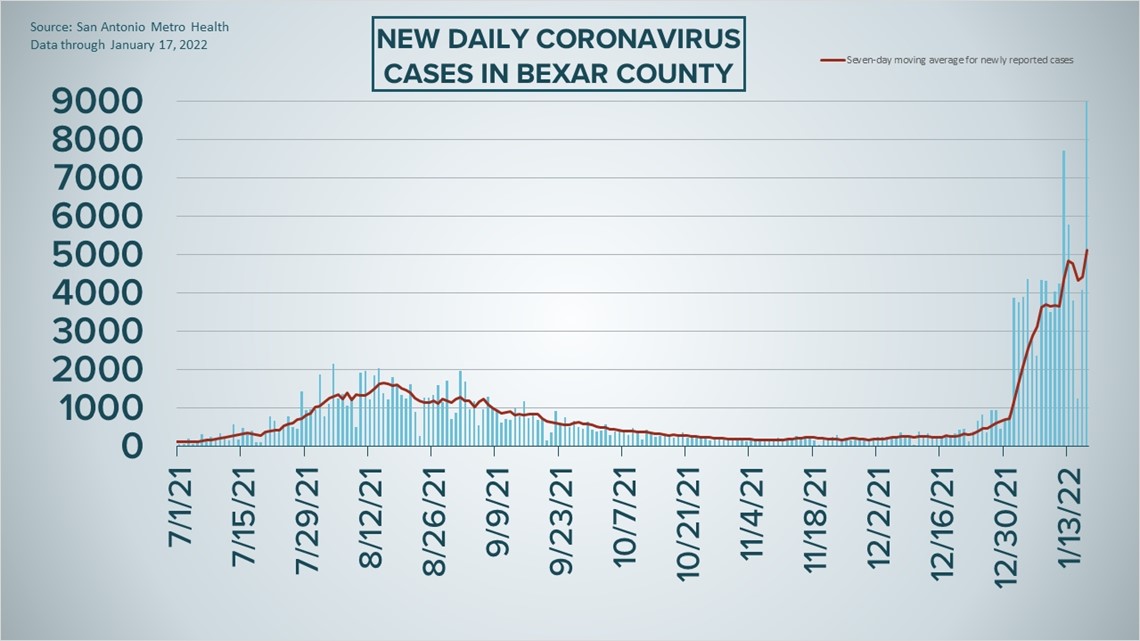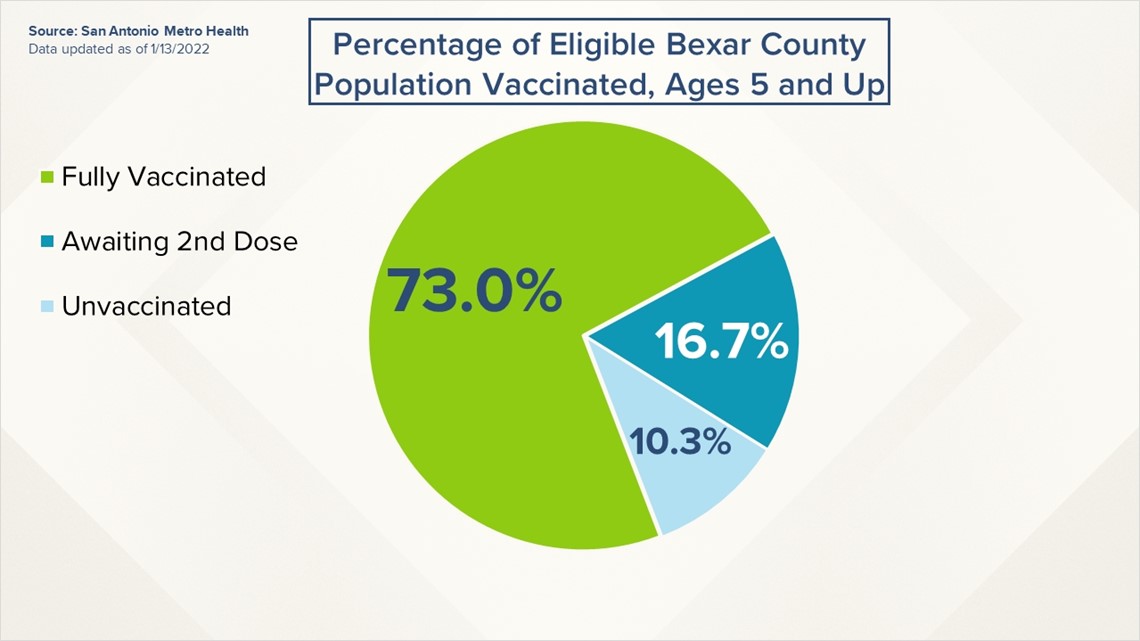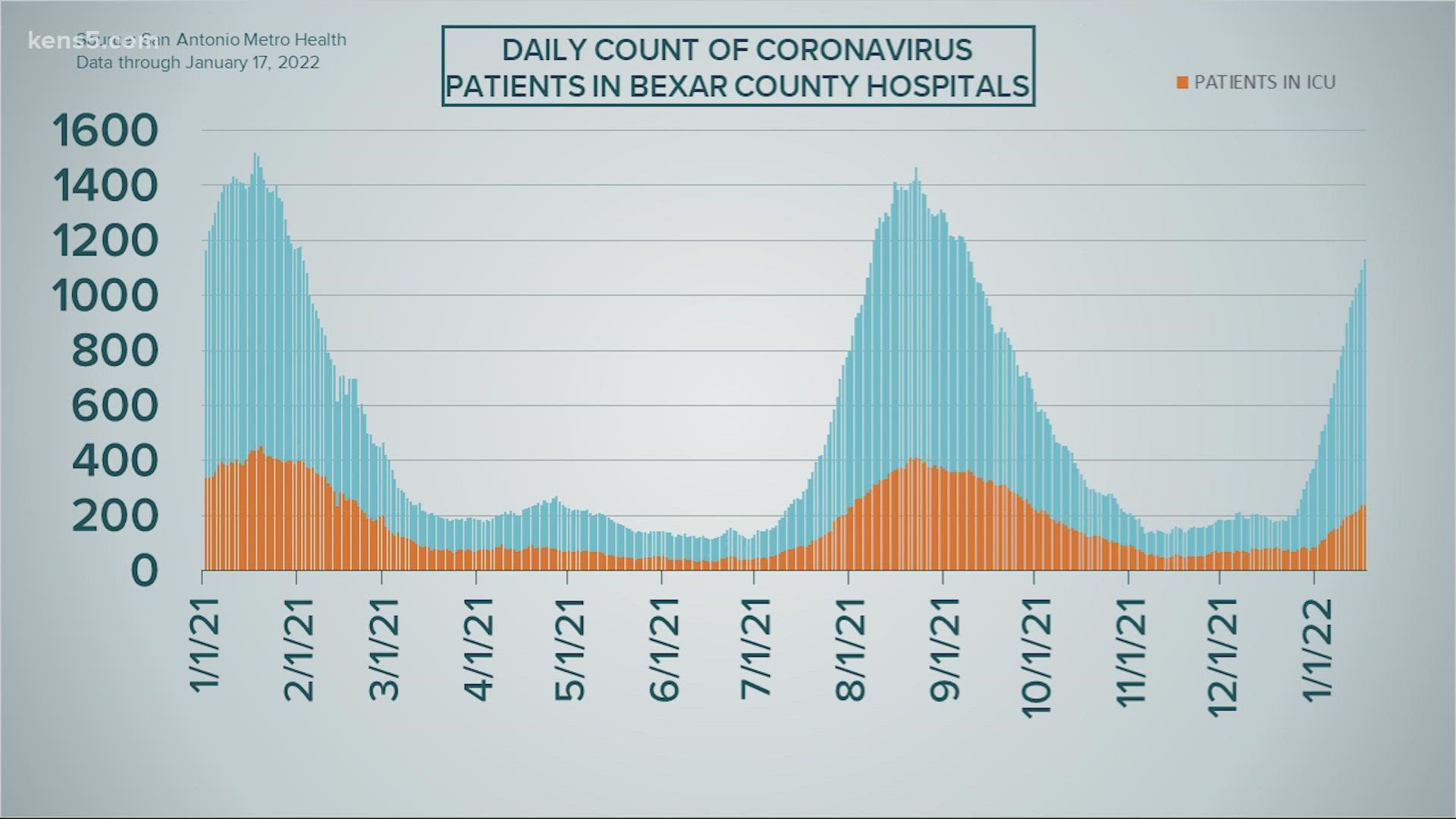SAN ANTONIO — Bexar County surpassed 400,000 total COVID-19 cases since the start of the pandemic over the weekend, and health authorities tacked on another 8,982 new diagnoses Monday—setting a new pandemic record for our area as the highly contagious omicron variant continues to run rampant.
The previous high was set just last week. Monday's count arrives as a federally operated coronavirus-testing site prepares to open at the Alamodome Wednesday morning, and contributed to a new high for the community's seven-day average of new cases, which stands at 5,119.
Metro Health reported a total of 5,325 additional cases over the weekend, including 4,077 on Sunday. The local death toll from virus complications remained at 5,006 as no new deaths have been reported since Thursday.
But hospitalizations rose again on Monday, as they have every day for the past three weeks. On Monday 1,129 Bexar County residents were receiving treatment at local hospitals for their symptoms, the most since Sept. 9.
Of those 1,129 patients, 239 are in intensive care and 94 were using ventilators.
Researchers at the University of Texas told KENS 5 last week they only expect hospitalizations to increase through the end of the month, predicting that Texas could double its current hospitalizations record by mid-February.
In all, more than 413,000 San Antonio-area residents have been diagnosed with COVID-19.
How Bexar County is trending




Vaccine Progress in Bexar County
The following numbers are provided by San Antonio Metro Health. A full breakdown can be found here.
- 1.699 million eligible Bexar County residents have received at least one dose of the coronavirus vaccine as of Thursday, Jan. 13, representing 89.7% of the county's population eligible (those over the age of 4) to receive a vaccination.
- 1.383 million eligible Bexar County residents are fully vaccinated as of Thursday, Jan. 13, representing 73% of the county's population eligible to receive a vaccination.


The CDC states that "when a high percentage of the community is immune to a disease (through vaccination and/or prior illness)," that community will have reached herd immunity, "making the spread of this disease from person to person unlikely."
The City of San Antonio breaks down the vaccination rates by zip code on Metro Health's Vaccination Statistics page.
Coronavirus in Texas
The total number of coronavirus cases in the state since the pandemic began grew by 68,268 on Monday, according to the Texas Department of State Health Services. That total includes 54,407 new confirmed cases and 13,861 new probable cases. More details can be found on this page.
Monday's figures bring the total number of Texans diagnosed with COVID-19 to more than 5.590 million.
An additional four Texans have died from virus complications, meanwhile, raising the statewide death toll to 76,000.
Coronavirus symptoms
The symptoms of coronavirus can be similar to the flu or a bad cold. Symptoms include fever or chills, cough, shortness of breath or difficulty breathing, fatigue, muscle or body aches, headache, new loss of taste or smell sore throat, congestion or runny nose, nausea or vomiting, and diarrhea, according to the Centers for Disease Control.
Most healthy people will have mild symptoms. A study of more than 72,000 patients by the Centers for Disease Control in China showed 80 percent of the cases there were mild.
But infections can cause pneumonia, severe acute respiratory syndrome, kidney failure, and even death, according to the World Health Organization. Older people with underlying health conditions are most at risk.
Experts determined there was consistent evidence these conditions increase a person's risk, regardless of age:
- Chronic kidney disease
- COPD (chronic obstructive pulmonary disease)
- Obesity (BMI of 30 or higher)
- Immunocompromised state (weakened immune system) from solid organ transplant
- Serious heart conditions, such as heart failure, coronary artery disease, or cardiomyopathies
- Sickle cell disease
- Type 2 diabetes
- The CDC believes symptoms may appear anywhere from two to 14 days after being exposed.
Human coronaviruses are usually spread...
- Between people who are in close contact with one another (within about 6 feet).
- Through respiratory droplets produced when an infected person coughs, sneezes or talks. These droplets can land in the mouths or noses of people who are nearby or possibly be inhaled into the lungs.
- Some recent studies have suggested that COVID-19 may be spread by people who are not showing symptoms.
Help stop the spread of coronavirus
- Stay home when you are sick.
- Eat and sleep separately from your family members
- Use different utensils and dishes
- Cover your cough or sneeze with your arm, not your hand.
- If you use a tissue, throw it in the trash.
Find a Testing Location
City officials recommend getting a COVID-19 test if you experience fever or chills, cough, shortness of breath or difficulty breathing, fatigue, muscle or body aches, headache, new loss of taste or smell, sore throat, congestion or runny nose, nausea or vomiting, or diarrhea.
Here's a Testing Sites Locator to help you find the testing location closest to you in San Antonio.
Latest Coronavirus Headlines
- New Austin COVID-19 orders go into effect Monday
- Texas mother who lost daughter to flu shares importance of getting vaccinated
- Federal COVID-19 testing site coming to the Alamodome
- Verify: Masks do help those with cedar fever
- Here are San Antonio's pop-up coronavirus vaccine clinics for Jan. 15 to Jan. 22
- Interest in N95 masks grows as omicron cases rise nationwide
- COVID-19 pills, expected to be a major tool, have rocky rollout as omicron rages
- After OSU study claims acids in hemp can prevent COVID-19, health experts say more research is needed
- Supreme Court halts COVID-19 vaccine-or-test rule for large businesses, keeps health care worker mandate

